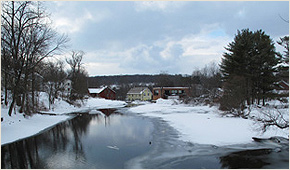- Hours:
- Sun-Thurs close at 9PM.
- Fri & Sat close 10PM
We are closed on 4 major holidays: Easter, 4th of July, Thanksgiving, and Christmas.
We are closed on 4 major holidays: Easter, 4th of July, Thanksgiving, and Christmas.


North Bennington – a small village in the Town of Bennington, Vermont – lies in the valley of Paran Creek.
The economic life of the village developed and flourished along the creek. A series of dams powered grist and lumber mills in the early years of settlement. These were gradually replaced by paper and furniture factories.
A century ago the village was a self-contained community that shipped goods around the nation. Cushman furniture produced in North Bennington became an American standard. Stereoption viewers ("magic lanterns") and children's scooters manufactured here were familiar products throughout the country. All the necessities and many of the amenities of life lay within a short walk.
Today most villagers drive to work elsewhere. Factories along the creek still manufacture goods, but several have been converted into housing. One functions as an art studio and nightclub. Another mill complex serves as an incubator for new businesses.
North Bennington was – and remains – an intensely local community that opens itself comfortably to others. Shirley Jackson's dark story of Yankee communal rites, The Lottery, was written here. Surely her inspiration was rooted in parochial aspects of the life she experienced on Prospect Street. Yet North Bennington has welcomed and nourished generations of poets, painters and writers like Jackson herself. Jamaica Kincaid, a long-time village resident, set her most recent novel, See Now Then, in the "Shirley Jackson House" above the "River Paran." Kenneth Noland, the abstract painter, maintained a studio here. Robert Frost wrote "Stopping by Woods on a Snowy Evening" on his farm just outside the village, and sent his daughter here to school.
The spirit of community remains strong in the village. If there were an accepted metric for volunteer commitment, the village would score high. Still there are serious challenges. Student population is dropping. Yet the village was named by Business Week for 2012 (and also in 2010) as the best place in Vermont to raise children, and rated second in the Bloomberg list for 2011. In the fall of 2013, the historic village school re-opened as an independent academy. With portable, publicly funded tuition, the village is experimenting with school choice. The dairy farm on the west slopes shuttered operations in the 1990s, but now the land is perpetually conserved and open for public recreation. Challenge creates opportunity.